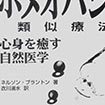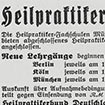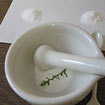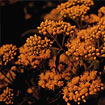Note
The texts of the exhibition were written until 2009. Since then, there have been no systematically additions. Regarding younger developements in the field of homeopathy the information given might not represent the actual state.

Homoeopathy Today
For over 200 years now homoeopathy has proved to be a successful healing method. Although there is not yet sufficient scientific evidence of how it works, its therapeutic efficacy is now also recognized by the World Health Organization (WHO).
Homoeopathy has proved amazingly successful in the treatment of chronic and allergic conditions such as rheumatism, migraines, asthma or skin disorders. We see these symptoms more and more often due to the ageing world population and the increasing pollution through harmful substances in everyday life.
As homoeopathy is by now practised all over the world, regional specialities develop. Homoeopaths often deal with specific challenges (disease symptoms) by using native, proven medicines. In some countries mostly complex remedies (consisting of more than one active agent) are prescribed, in others the ‘classical’ single remedies dominate.

Since the 1980s the demand for homoeopathic treatment and homoeopathic medicines has grown worldwide. By 2005, almost a third of all Germans had tried homoeopathy; in France it was even 40 %. Everywhere, the majority of homoeopathy users are women, most have higher education, are rather dissatisfied with their state of health and have an above average interest in health issues. They want to have a say as patients. About three quarters of Europeans wish to see complementary and alternative medicine (CAM) more strongly represented in their health systems. Patients who use CAM are younger than average, which points to a potential further expansion of homoeopathy.
The number of homoeopathic practitioners is growing disproportionately fast. Almost half of all German general practitioners prescribe homoeopathic medicines ‘very often, often or occasionally’ according to a representative survey. Around 6,000 physicians have adopted the additional title ‘homoeopathic doctor’, three times as many as in 1993. The percentage of homoeopaths among general practitioners now amounts to almost 3 %. The number of non-medical practitioners with homoeopathic specialization is also on the increase.
Comparable growth tendencies can also be observed in other European countries: the percentage of physicians with an equivalent homoeopathic specialization is in some countries higher now than in Germany. In India, Brazil and other nations the number of homoeopaths is also growing fast.
Globalization has also benefited homoeopathy: In Japan, for instance, where there used to be just a few homoeopathic physicians, Torako Yui started a very successful school in 1997 where 700 homoeopaths have been trained over the last ten years. A patients’ association which she also initiated is said to have already 20,000 members. In Sri Lanka and Malaysia the health ministries are seeking to obtain information about the efficacy and potential of homoeopathy. In the United Arab Emirates, where homoeopathy has so far not been practised, it is being discovered by physicians now. In South Africa and Australia interest is also growing.

Only physicians with a further specialization in homoeopathy are allowed to use the title ‘homoeopathic physician’ in Germany. So far, the method has not been firmly established at any universities in Europe. There are, at best, teaching assignments which convey the basic knowledge to medical students. The training of homoeopathic physicians therefore takes place in further training courses that are offered by the homoeopathic physicians’ associations or institutes.
Apart from homoeopathic general practitioners, there are also gynaecologists, paediatricians, dentists and veterinarians who offer homoeopathic treatment. Veterinary homoeopathy is steadily gaining importance in some European countries because this kind of treatment, among other things, avoids the drug residue in the animal that tends to reduce its potential for further usage.
Many activities are striving to improve the training of physicians and non-medical practitioners (in Germany). In other European countries the unification of standards is still the most urgent issue. The European Committee for Homoeopathy already published the relevant recommendations in 1994.

The homoeopathic pharmaceutical market has been growing by about 5 % per annum since the mid-1990s. By now, homoeopathic medicines account for almost 1 % of the European pharmaceutical market, but only 0.3 % worldwide.

Research is supported by the manufacturers and a few foundations. As homoeopathy is not established yet at the universities, it is investigated there only in exceptional cases. In the last two decades individual European countries such as Germany and Denmark have initiated small-scale temporary research programmes which also benefited homoeopathy. The British National Health Service supports clinical research to an extent, while India has a broad infrastructure for homoeopathic research.
It still has not been explained satisfactorily how homoeopathy works. More recent investigation has, however, confirmed that highly potentized (i. e. very strongly diluted and succussed) substances do affect humans, animals, plants, cells and enzymes. One explanation for this might be that the potentization and the extra energy it provides cause a restructuring of the solvent.
More important are the studies on the actual, observable effect of homoeopathic treatment. Evaluation of over 600 homoeopathy trials carried out in 2006 for the Swiss Bundesamt für Sozialversicherung (Department of Social Security) showed clearly that there is sufficient evidence of the preclinical and clinical efficacy of homoeopathy. It is, in its own right and compared to orthodox therapies, a safe and usually cost-saving method. Some studies carried out by German health insurance companies confirm that its effect is sustained which means that it reduces the cost of health care indirectly.


